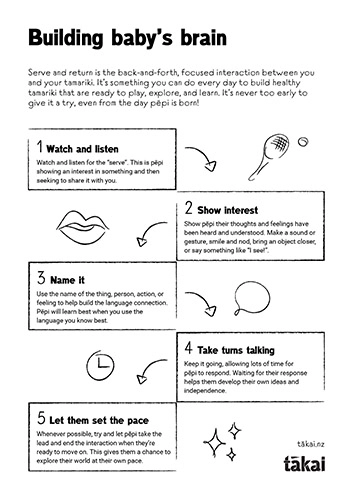
Building brains through serve and return
“Serve and return” is a name for the back-and-forth, focused interaction between pēpi and adults. Taking the time to engage with pēpi in everyday activities will help to develop strong bonds and build brains that are ready to explore and learn.
We intuitively know that connecting with tamariki through play, cuddles, waiata , and affection is important. The back-and-forth nature of these interactions is called serve and return. While the concept is grounded in the latest research, serve and return affirms tīpuna Māori practices of recognising the mana of tamariki through responding and nurturing.
The back-and-forth, loving interactions we have with young tamariki build the foundation for later brain development, learning, and emotional, mental and physical health. This back and forth shows tamariki that they’re important and we value what they think and how they feel. Pēpi in particular benefit because their brains are developing so rapidly.
Serve and return interactions may be particularly important when tamariki have experienced stress or adversity.
Ways to incorporate serve and return
Serve and return can be as simple as singing a waiata together, sharing a laugh, or a child pointing to a bird out the window and the adult responding, “it’s a bird flying through the sky”. The activity itself doesn’t really matter – what matters most is the connection, the common interest, and the ‘rally space’ of mutual back and forth.
A “serve” can be anything that a child shows an interest in and then wants to share, such as an object, a feeling, an action, or a person. These happen throughout the day and can be found in small moments, like getting them dressed, waiting in line in the supermarket, reading a book, hanging out the washing, or going for a walk.
Some activities that really get connection going are playing peek-a-boo, singing waiata together, and walking in nature and talking about what you see.
Here are some tips to try when connecting with tamariki:
1. Watch and listen
Watch for what pēpi is interested in (the “serve”). They may point or make noises or facial expressions. Even before pēpi can say words they still communicate by babbling or through eye contact.
Looking for the “serve” and responding with interest can be a great way to learn about a child’s interests and encourage them to be curious.
2. Show interest
This can be as simple as making a sound, taking a closer look with pēpi, using a facial expression, or saying something like “That’s right!” or “Look at that!” This shows pēpi that their thoughts and feelings have been heard and understood. Talking with pēpi helps nourish their developing brain.
3. Name it
Use the name of the thing, person, action, or feeling to help build the language connection. This helps pēpi understand the world around them. They will learn best when you use the language you know best.
For example, you can name things they point at while reading a pukapuka .
4. Take turns talking
Keep it going, allowing time for pēpi to respond. Waiting is important because it helps them develop their own ideas and independence. As you chat back and forth, notice how they watch and listen to you.
5. Let them set the pace
Whenever possible, try and let pēpi take the lead and end the interaction when they’re ready to move on. This gives them a chance to explore their world at their own pace.
Serve and return is something whānau can do every day to build healthy pēpi that are ready to play, explore, and learn. It's never too early to give it a try, even from the day pēpi is born!
Helpful resources for whānau
-
Serve and return<
Serve and returnThis video outlines the serve and return process that helps to lay a strong foundation for the brain development of your tamariki.
-
Growing great brains<
Growing great brainsJason Tiatia from the Brainwave Trust shares some tips on helping pēpi grow great brains.
-

Feeding your baby's brain
Brainwave Trust Aotearoa
Using lots of language from the time pēpi is born will help to grow their brain. Here are some tips on ways to talk more with pēpi.
 pdf 4.6 MB
pdf 4.6 MB












